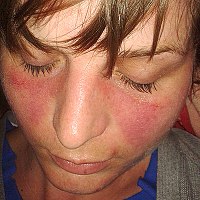
Blood transcriptomic biomarker as a surrogate of ischemic brain gene expression
Sign Up to like & getrecommendations! Published in 2019 at "Annals of Clinical and Translational Neurology"
DOI: 10.1002/acn3.50861
Abstract: Blood biomarkers for cerebral tissue ischemia are lacking. The goal was to identify a blood transcriptomic signature jointly identified in the ischemic brain. read more here.
Keywords: biomarker surrogate; blood transcriptomic; blood; ischemic brain ... See more keywords

Affinity-Immobilization of VEGF on Laminin Porous Sponge Enhances Angiogenesis in the Ischemic Brain.
Sign Up to like & getrecommendations! Published in 2017 at "Advanced healthcare materials"
DOI: 10.1002/adhm.201700183
Abstract: Ischemic brain stroke is caused by blood flow interruption, leading to focal ischemia, neuron death, and motor, sensory, and/or cognitive dysfunctions. Angiogenesis, neovascularization from existing blood vessel, is essential for tissue growth and repair. Proangiogenic… read more here.
Keywords: sponge; laminin; affinity immobilization; ischemic brain ... See more keywords

Reduction of Ischemic Brain Edema by Combined use of Paeoniflorin and Astragaloside IV via Down‐Regulating Connexin 43
Sign Up to like & getrecommendations! Published in 2017 at "Phytotherapy Research"
DOI: 10.1002/ptr.5868
Abstract: Paeoniflorin (PF) and astragaloside IV (AS‐IV) have protective effects on cerebral ischemia. We aimed to test the effects of combined use of PF and AS‐IV on ischemic brain edema and investigate whether the effects were… read more here.
Keywords: brain edema; edema; cx43; ischemic brain ... See more keywords

Neuroprotective effects of icariin in neonatal hypoxia-ischemic brain damage via its anti-apoptotic property
Sign Up to like & getrecommendations! Published in 2020 at "Child's Nervous System"
DOI: 10.1007/s00381-020-04690-8
Abstract: Introduction Neonatal hypoxic-ischemic brain damage (HIBD) is a brain disease that is caused by perinatal asphyxia. Icariin (ICA), which is an active component of Epimedii (a Chinese medicinal herb), has been verified to demonstrate a… read more here.
Keywords: neuroprotective effects; anti apoptotic; brain damage; brain ... See more keywords

Neuroprotective effects of neurotropin in a mouse model of hypoxic–ischemic brain injury
Sign Up to like & getrecommendations! Published in 2019 at "Journal of Anesthesia"
DOI: 10.1007/s00540-019-02655-z
Abstract: PurposeIschemic–hypoxic insult leads to detrimental effects on multiple organs. The brain is especially vulnerable, and it is hard to regenerate once damaged. Currently, therapeutic options are very limited. Previous studies have reported neuroprotective effects of… read more here.
Keywords: neuroprotective effects; hypoxic ischemic; ischemic brain; brain injury ... See more keywords

Epigallocatechin Gallate Alleviates Down-Regulation of Thioredoxin in Ischemic Brain Damage and Glutamate-Exposed Neuron.
Sign Up to like & getrecommendations! Published in 2021 at "Neurochemical research"
DOI: 10.1007/s11064-021-03403-0
Abstract: Epigallocatechin gallate (EGCG) is one of polyphenol that is abundant in green tea. It has anti-oxidative activity and exerts neuroprotective effects in ischemic brain damage. Ischemic conditions induce oxidative stress and result in cell death.… read more here.
Keywords: thioredoxin; glutamate; ischemic brain; brain damage ... See more keywords

Targeting Complement C3a Receptor to Improve Outcome After Ischemic Brain Injury
Sign Up to like & getrecommendations! Published in 2021 at "Neurochemical Research"
DOI: 10.1007/s11064-021-03419-6
Abstract: Ischemic stroke is a major cause of disability. No efficient therapy is currently available, except for the removal of the occluding blood clot during the first hours after symptom onset. Loss of function after stroke… read more here.
Keywords: c3a receptor; improve outcome; outcome; outcome ischemic ... See more keywords

Resveratrol Improves Synaptic Plasticity in Hypoxic-Ischemic Brain Injury in Neonatal Mice via Alleviating SIRT1/NF-κB Signaling–Mediated Neuroinflammation
Sign Up to like & getrecommendations! Published in 2021 at "Journal of Molecular Neuroscience"
DOI: 10.1007/s12031-021-01908-5
Abstract: Neonatal hypoxic-ischemic encephalopathy (HIE) is an obstinate disease that troubles neonatologists. At present, cognitive impairment after HIE has received increasing attention. Synaptic plasticity determines the development of cognitive function, so it is urgent to develop new… read more here.
Keywords: brain injury; synaptic plasticity; ischemic brain; resveratrol ... See more keywords

Positron Emission Tomography After Ischemic Brain Injury: Current Challenges and Future Developments
Sign Up to like & getrecommendations! Published in 2020 at "Translational Stroke Research"
DOI: 10.1007/s12975-019-00765-0
Abstract: Positron emission tomography (PET) is widely used in clinical and animal studies, along with the development of diverse tracers. The biochemical characteristics of PET tracers may help uncover the pathophysiological consequences of cardiac arrest (CA)… read more here.
Keywords: positron emission; brain; ischemic brain; brain injury ... See more keywords

Tenascin-C preserves microglia surveillance and restricts leukocyte and, more specifically, T cell infiltration of the ischemic brain
Sign Up to like & getrecommendations! Published in 2021 at "Brain, Behavior, and Immunity"
DOI: 10.1016/j.bbi.2020.10.016
Abstract: As an endogenous activator of toll-like receptor-4 (Tlr4), the extracellular matrix glycoprotein tenascin-C (TnC) regulates chemotaxis, phagocytosis and proinflammatory cytokine production in microglia. The role of TnC for ischemic brain injury, post-ischemic immune responses and… read more here.
Keywords: microglia surveillance; ischemic brain; brain; tnc deficiency ... See more keywords

Vγ4 T cell-derived IL-17A is essential for amplification of inflammatory cascades in ischemic brain tissue after stroke.
Sign Up to like & getrecommendations! Published in 2021 at "International immunopharmacology"
DOI: 10.1016/j.intimp.2021.107678
Abstract: BACKGROUND Through amplifying inflammatory cascades, IL-17A produced by γδ T cells potently attracts neutrophils to the site of injury for exacerbating ischemic tissue damage. Our goal was to identify the precise role of γδ T… read more here.
Keywords: brain tissue; tissue; inflammatory cascades; ischemic brain ... See more keywords